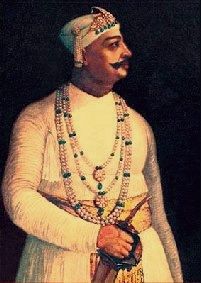Sikander Jah, Asaf Jah III
| Sikander Jah | |||||
|---|---|---|---|---|---|
| Nizam-ul-Mulk | |||||
 | |||||
| 6th Nizam of Hyderabad State | |||||
| Reign | 6 August 1803— 21 May 1829 | ||||
| Predecessor | Nizam Ali Khan | ||||
| Successor | Nasir-ud-Daulah | ||||
| Born | Mir Akbar Ali Khan Siddiqi 11 November 1768 Chowmahalla Palace (Khilwat), Hyderabad, Hyderabad State (now in Telangana, India) | ||||
| Died | 21 May 1829 (aged 61) Hyderabad, Hyderabad State (now in Telangana, India) | ||||
| Burial | Mecca Masjid, Hyderabad, Hyderabad State (now in Telangana, India) | ||||
| Spouse | Jahan Parwar Begum Fazilat-un-Nisa Begum | ||||
| Issue |
| ||||
| |||||
| Father | Nizam Ali Khan, Asaf Jah II | ||||
| Mother | Tinat-un-Nisa Begum | ||||
Sikander Jah, Asaf Jah III (11 November 1768 – 21 May 1829), was the 6th Nizam of Hyderabad, India from 1803 to 1829.[1] He was born in Chowmahalla Palace in the Khilwath, the second son of Asaf Jah II and Tahniat un-nisa Begum.
Family[edit]
- Consorts
One of his wives was Jahan Parwar Begum also known as Hajji Begum.[2] She was the daughter of Azim ul-Umara[3] also known as Ma'ali Mian and Farzand Begum. She was the granddaughter of Aristu Jah, from whom she inherited Purani Haveli,[2] and the niece of Munir ul-Mulk.[3] She was the mother of Mir Tafazzul Ali Khan, also known as Mir Badsha,[4] and Namdar-un-Nisa Begum.[5] She died on 21 May 1853.[6] Another wife was Fazilat-un-nisa Begum also known as Chandni Begum. She was the mother of Nasir-ud-Daulah and Mubarez-ud-Daulah.[7]
- Daughters
- Jamal-un-Nisa Begum (died 22 March 1855, buried near her husband), married to Rafi-ud-Daulah, the brother of Safdar-ud-Ddaulah, the Nizam of Surat;[8]
- Kamal-un-Nisa Begum, married to Mir Moin-un-Din Husain Khan, Ghazanfar Jung, Imtiaz-ud-Daulah;[9]
- A daughter, married on 25 May 1821 to the son of Zafar-Yab Jung;[10]
- Sultan-un-Nisa Begum, married on 25 December 1830 to Mohammed Sultan-ud-din Khan, Sabqat Jang, Muhtasham-ud-Daula, son of Nawab Shams-ul-Umara Bahadur;[11][12]
- Namdar-un-Nisa Begum, married on 15 August 1839 to Mir Abdul Qasim Sohrab Jang Moin-ud-Daulah, a relative of Mir Alam;[5]
- Hashmat-un-Nisa Begum, married to Shams ul-Umara, Vikar ul-Umara, Amir-i-Kabir, Iqtidar ul-Mulk, Iqtidar ud-Daulah, Nawab Abul Khair Khan Bahadur;[12]
Official name[edit]
His original names were Sikandar Jah, Asaf ul-Mulk, Asad ud-Daula, Walashan Nawab Mir Akbar 'Ali Khan Siddiqi Bahadur, Asad Jang. He was officially known as Asaf Jah III, Nizam ul-Mulk, Nizam ud-Daula, Mir Akbar 'Ali Khan Siddiqi Bahadur, Faulad Jang, Nizam of Hyderabad.[13]
Military expansion[edit]
During his reign, a British cantonment was established near Hyderabad and the area was christened after him as Secunderabad. His son Samsamadaula (Mir Basheeruddin Ali Khan) was Defence Adviser to his brother, Nasir ud Daula, and nephew, Afzal ud daula. But he did not have any pact with the British for maintaining the contingent. The state was in a financial mess during his reign.[14][15]
Sikh Regiment[edit]
Upon the recommendation of Maharaja Chandu Lal, a Punjabi Khatri and influential dignitary at the Nizam's court. 1200+ Sikh soldiers joined the Nizam's army. Around 1830, Maharaja Ranjit Singh sent 150 more men under a Sardar Chanda Singh, for the construction of Gurdwara Takht Sachkhand Sri Hazur Sahib Abichalnagar at Nanded.[16][17]
Building of temple[edit]
Sikander Jah not only built the Rambagh temple in Attapur, Hyderabad but also attended the inauguration ceremony proving again the communal harmony that existed between the Muslim Asaf Jahi rulers and their Hindu subjects in Hyderabad. The Nizam also granted a Jagir to the temple priest for the temple's maintenance.[18][19]
See also[edit]
References[edit]
- ^ "The University of Queensland Homepage".
- ^ a b Roychoudhury, U. (2004). White Mughals. Penguin Group. p. xxiii. ISBN 978-0-14-303046-1.
- ^ a b Wilkinson, C. (2023). Empire of Influence. Cambridge University Press. p. 232. ISBN 978-1-009-31173-1.
- ^ Rao 1954, p. 269.
- ^ a b Rao 1954, p. 216.
- ^ Rao 1954, p. 268.
- ^ Rao 1954, p. 198.
- ^ Rao 1954, pp. 17, 27, 278–279.
- ^ Rao 1954, p. 16.
- ^ Rao 1954, p. 164.
- ^ Rao 1954, p. 196.
- ^ a b Bawa, B.K. (1992). The Last Nizam: The Life and Times of Mir Osman Ali Khan. Viking. p. 2. ISBN 978-0-670-83997-1.
- ^ "Seven Asaf Jah Rulers - Seven Nizams". Retrieved 21 September 2019.
- ^ "Asaf Jahis". AP state portal. Ap state portal. Retrieved 19 September 2019.
- ^ "Asaf Jahis (1724-1948)". Retrieved 21 September 2019.
- ^ "Dakkhani Sikhs - SikhiWiki, free Sikh encyclopedia". www.sikhiwiki.org.
- ^ Singh, S. Harpal (29 December 2019). "Guru Nanak's centuries-old link with Nizam's Nirmal". The Hindu. Retrieved 28 April 2021.
- ^ Nanisetti, Serish (8 April 2017). "Nizam built this temple". The Hindu. thehindu. Retrieved 8 July 2020.
- ^ "Rambagh temple, a hidden gem in the Hyderabad".
Bibliography[edit]
- Rao, Ekbote Gopal (1954). The Chronology of Modern Hyderabad, 1720-1890. Central Records Office Hyderabad Government.
External links[edit]

